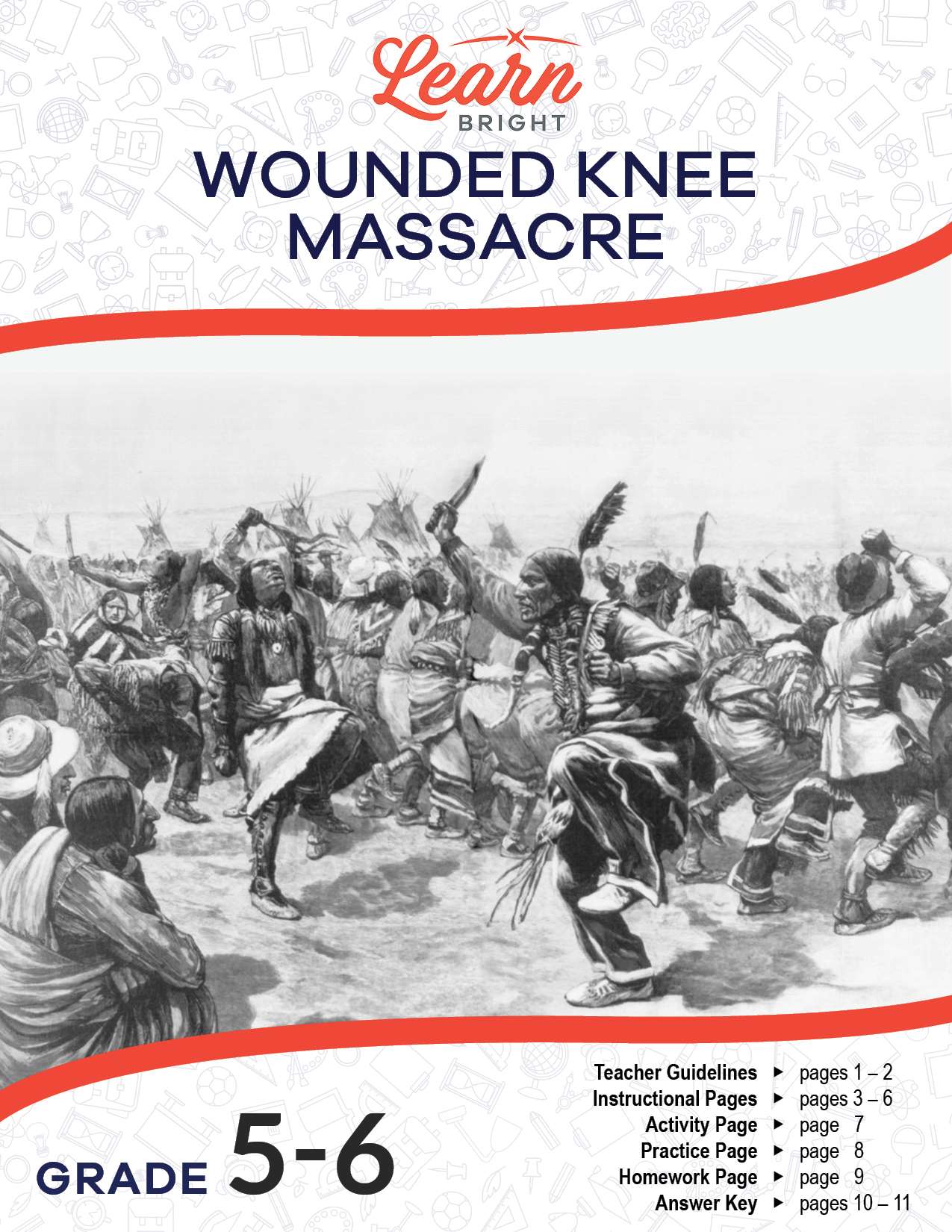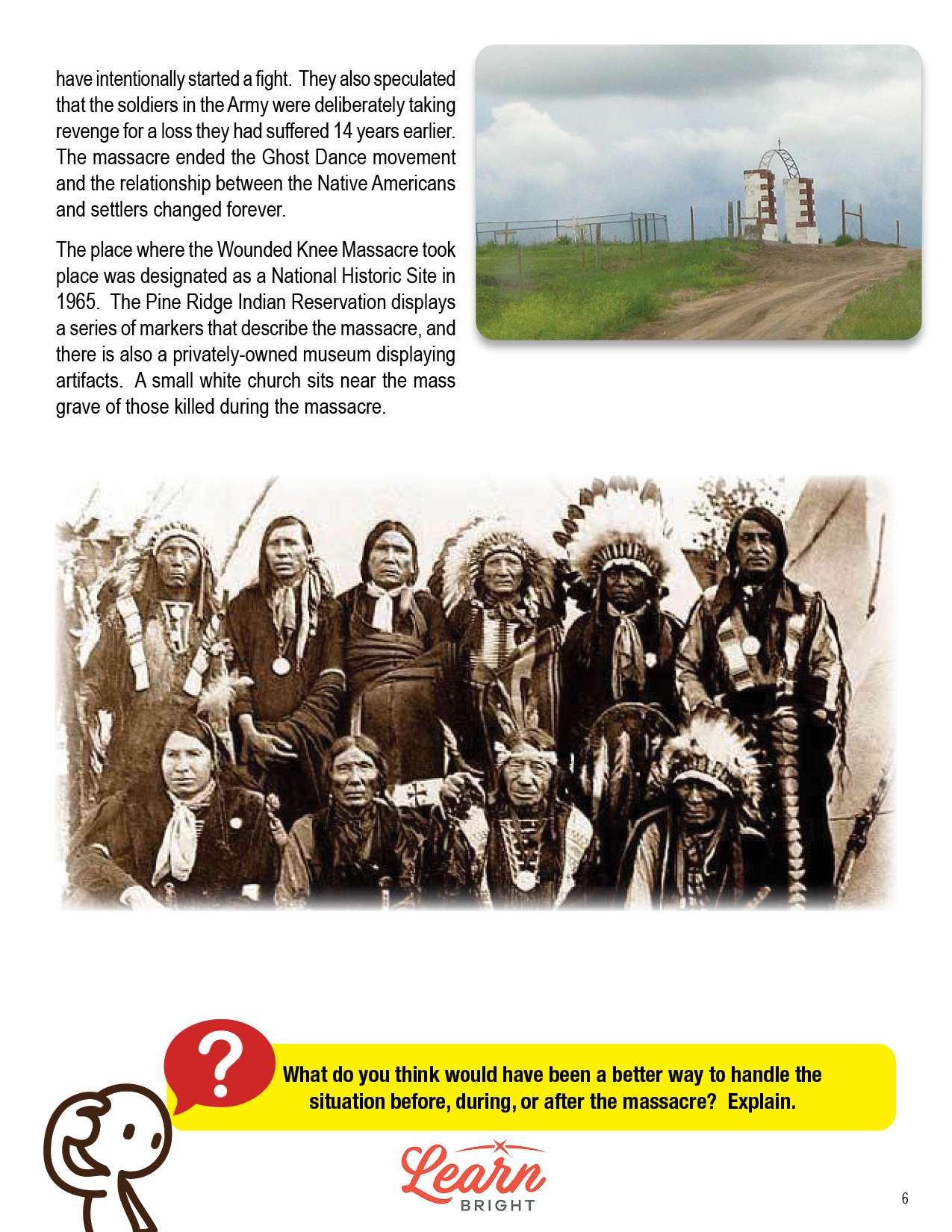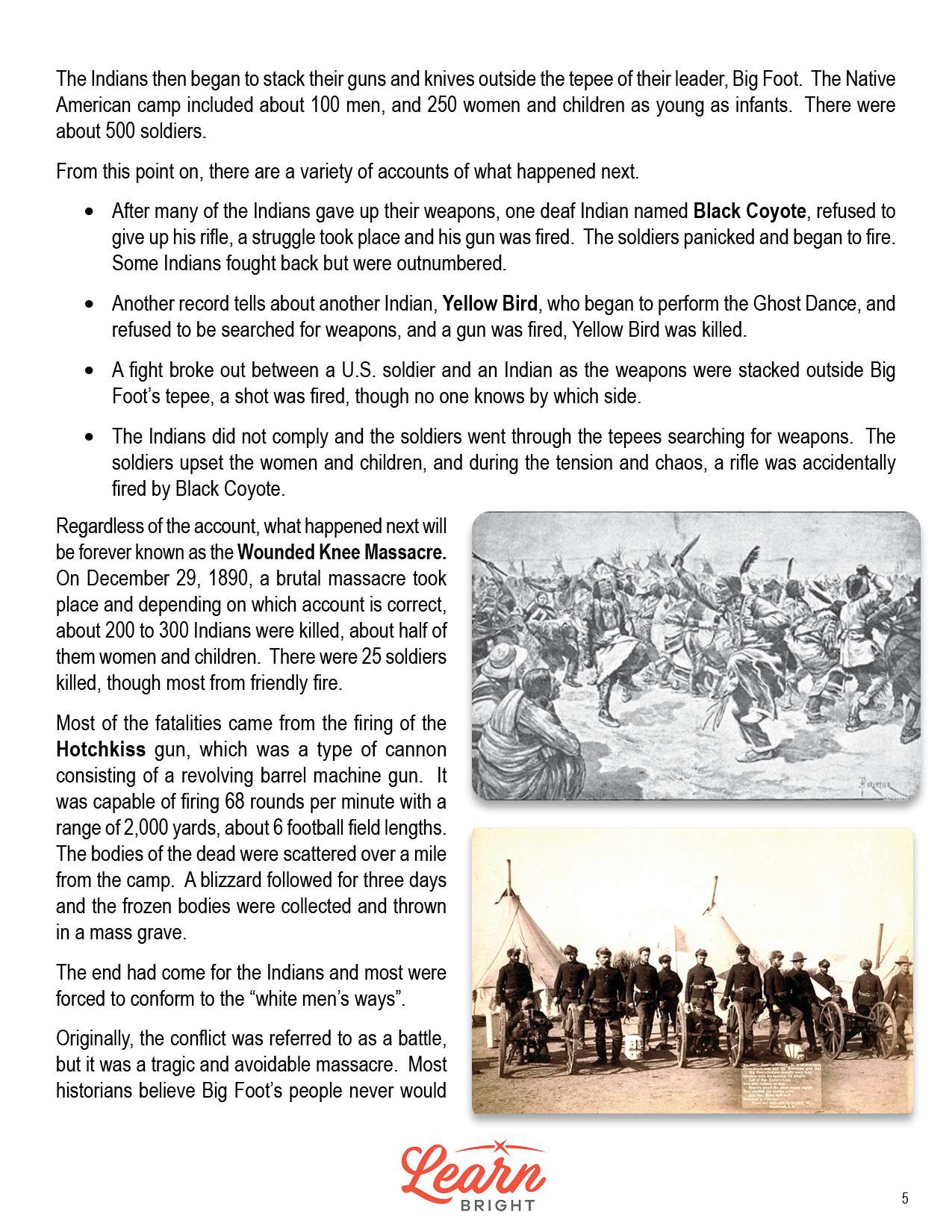Description
What our Wounded Knee Massacre lesson plan includes
Lesson Objectives and Overview: Wounded Knee Massacre introduces students to the final major conflict between Native-Americans and the U.S. Army, a controversial one-sided battle where the U.S. government killed over 200 men, women, and children of the Lakota Indian Tribe. The lesson includes Native American/U.S. background information. At the end of the lesson, students will be able to describe the Wounded Knee Massacre, the cause and impact, and identify key participants of the conflict. This lesson is for students in 5th grade and 6th grade.
Classroom Procedure
Every lesson plan provides you with a classroom procedure page that outlines a step-by-step guide to follow. You do not have to follow the guide exactly. The guide helps you organize the lesson and details when to hand out worksheets. It also lists information in the orange box that you might find useful. You will find the lesson objectives, state standards, and number of class sessions the lesson should take to complete in this area. In addition, it describes the supplies you will need as well as what and how you need to prepare beforehand. The supplies you will need for this lesson are construction paper, markers, colored pencils, and the handouts.
Options for Lesson
Included with this lesson is an “Options for Lesson” section that lists a number of suggestions for activities to add to the lesson or substitutions for the ones already in the lesson. To add to the lesson activity, you can have students vote on the best, most creative, best message for each type of poster. For an additional activity you could visit a Native American museum or similar location with your class. You can discuss different confrontations, like Wounded Knee, with your class. For an additional activity, you could invite an expert on Native American history to speak to your class about Wounded Knee. You could also plan a Native American Day or Week, using other Native American lessons or topics each day. Finally, you could split your class in half and have students debate land ownership from the perspective of the Native Americans and the U.S. government.
Teacher Notes
The teacher notes page includes a paragraph with additional guidelines and things to think about as you begin to plan your lesson. This page also includes lines that you can use to add your own notes as you’re preparing for this lesson.
WOUNDED KNEE MASSACRE LESSON PLAN CONTENT PAGES
Native Americans in the United States
The Wounded Knee Massacre lesson plan includes four content pages. Christopher Columbus made his first contact with people in what he believed were the East Indies in Southeast Asia in 1492. Because of his misunderstanding, he called these people Indians. However, today we call them Native Americans, as they were the first people to occupy the Americas. They are the indigenous people, and settled the land long before European settlers arrived and began colonizing it. These settlers would eventually, many years later, found the United States of America there.
During Westward Expansion by the colonists, they often had a peaceful relationship with the Native Americans. However, there were also inevitable conflicts, battled, and other struggles between the two groups, as the Native Americans did not want to lose their homes, people, and lifestyles.
Historians generally agree that the colonists took advantage of the Native Americans by taking the land that they lived on for a long, long time away from them. The colonists killed many Native Americans between the time Columbus arrived in 1492 and the 1800s. Most of the conflicts were about land acquisitions and the fact that the colonists were ignorant about the lives of the Native Americans.
The Native American people had a different culture and it sometimes scared the colonists. As the colonist population grew, they needed more land. The U.S. government passed several laws that opened Native American land to the settlers, against the wishes of the Native Americans who already lived there.
The Ghost Dance
Many Native American people were spiritual and expressed their religion through dance and other customs. In 1890, a newspaper covered a Native American dance called the Ghost Dance. The newspaper portrayed this ritual as an uprising. The settlers thought that the Native Americans performed this dance to prepare to battle against them.
That year, President Benjamin Harrison ordered the military to take control of several Lakota reservations. The Ghost Dance was actually a religious movement, as many Native Americans wanted to return to their former way of life. They practiced the dance as a means to help get the white invaders to leave their lands. They thought that, if they practiced the dance and rejected the ways of the white settlers, their gods would recreate the world and rid their lands of the colonists.
This sacred the settlers, and on December 15, 1890, they decided that they should stop the Ghost Dance. They arrested Native American leader Sitting Bull at Standing Rock Reservation because they mistook him for a Ghost Dancer. During his arrest, a fight broke out. They killed Sitting Bull, a famous Sioux chief.
The Massacre
During the two weeks following the murder of Sitting Bull, tensions rose. The settlers arrested Big Foot (also known as Chief Spotted Elk), a leader of another band of the Lakota Tribe, as a troublemaker. He learned of Sitting Bull’s death and his people started moving towards the Pine Ridge Reservation in search of shelter and safety.
The U.S. Army pursued them as they traveled, believing that violence might break out and put settlers in danger. The Native Americans managed to avoid the Army for five days, and Big Foot caught pneumonia. The U.S. government demanded that the Native Americans give up their weapons, believing that this would help bring peace.
On December 28th, under the command of Colonel James Forsythe, the Army intercepted the group and forced them to a camp at Wounded Knee Creek. Forsythe told them to give up their weapons.
The Native Americans stacked their guns and other weapons outside Big Foot’s teepee. At the camp were 100 Native American men and 250 women and children. There were about 500 soldiers as well.
We don’t know exactly what happened next, but we have a few different accounts. One of these accounts states that a deaf Native American man named Black Coyote refused to give up his rifle, struggled with the settlers, and accidentally fired his gun. After that, the soldiers panicked and fired on the Native Americans, who fought back. The soldiers outnumbered them, however.
Another account states that another Native American, Yellow Bird, began to perform the Ghost Dance. They also refused to be searched and the soldiers killed him.
Yet another account states that a U.S. solider and Native American got into a fight while they stacked their weapons outside Big Foot’s tent. Someone, on an unknown side, shot a weapon, and fighting began.
A final account states that the Native Americans did not comply with orders and the soldiers went through their tents looking for weapons. Black Coyote then accidentally fired a weapon while tensions grew.
Despite how it started, we call the next events the Wounded Knee Massacre. On December 29, 1890, United States soldiers brutally massacred 200 to 300 Native Americans, about half of whom were women and children. 25 soldiers died, mostly from friendly fire.
Many people died from shots from a Hotchkiss gun, a type of cannon consisting of a revolving barrel machine gun. It could fire 68 rounds per minute with a range of 2,000 yards. The soldiers scattered the bodies of the dead more than a mile from camp. A blizzard over the next three days froze the bodies, which they then threw into a mass grave. This marked a huge loss for the Native Americans, many of whom the settlers forced to conform.
People originally referred to this incident as a battle, but it was actually an avoidable massacre. Historians believe that Big Foot’s people would not have started a fight and that the soldiers deliberately took revenge for a battle they’d lost 14 years earlier. This massacre ended the Ghost Dance movement and changed the relationship between the United States and the Native Americans forever.
In 1965, the government declared the site of the Wounded Knee Massacre a National Historic Site. The Pine Ridge Indian Reservation also displays markers to commemorate the massacre. A privately-owned museum nearby also displays artifacts. Today, a small white church sits near the mass grave.
Key Terms
Here is a list of the vocabulary words students will learn in this lesson plan:
- Native Americans: The first people to occupy and settle in America
- The Ghost Dance: Religious movement that the Native Americans used
- Lakota: Harrison ordered take-overs of these reservations
- Standing Rock Reservation: Reservation where they arrested Sitting Bull
- Sitting Bull: Native American chief during his arrest
- Big Foot: Native American chief also known as Spotted Elk
- Pine Ridge Reservation: Big Foot’s people moved here to seek safety and shelter
- Colonel James Forsythe: Colonel who lead the U.S. Army during the massacre
- Black Coyote: May have been a deaf Indian, refused to give up his rifle
- Yellow Bird: May have refused to be searched for weapons
- Wounded Knee Massacre: Massacre that killed 200 to 300 Native Americans
- Hotchkiss: Type of gun/cannon used at Wounded Knee
WOUNDED KNEE MASSACRE LESSON PLAN WORKSHEETS
The Wounded Knee Massacre lesson plan includes three worksheets: an activity worksheet, a practice worksheet, and a homework assignment. You can refer to the guide on the classroom procedure page to determine when to hand out each worksheet.
POSTER ACTIVITY WORKSHEET
The activity worksheet asks students to design and create one or more posters that honor the Native Americans killed by the government, encourages peace between people, encourages people to respect each other, or summarizes the events at Wounded Knee. They will create a rough draft and a final version.
Students can also work in pairs to complete this activity.
MATCHING PRACTICE WORKSHEET
For the practice worksheet, students will first match terms from the lesson with their definitions or descriptions. They will then write down the significance of five numbers.
WOUNDED KNEE MASSACRE HOMEWORK ASSIGNMENT
The homework assignments asks students to respond to eight questions about the lesson material. They will then respond to several questions with their opinions, giving a reason for each opinion.
Worksheet Answer Keys
This lesson plan includes answer keys for the practice worksheet and the homework assignment. If you choose to administer the lesson pages to your students via PDF, you will need to save a new file that omits these pages. Otherwise, you can simply print out the applicable pages and keep these as reference for yourself when grading assignments.









